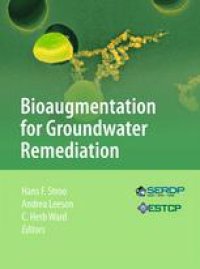
Ebook: Bioaugmentation for Groundwater Remediation
- Tags: Environmental Management, Water Quality/Water Pollution, Waste Water Technology / Water Pollution Control / Water Management / Aquatic Pollution, Civil Engineering, Applied Microbiology
- Series: SERDP ESTCP Environmental Remediation Technology 5
- Year: 2013
- Publisher: Springer-Verlag New York
- Edition: 1
- Language: English
- pdf
This volume provides a review of the past 10 to 15 years of intensive research, development and demonstrations that have been on the forefront of developing bioaugmentation into a viable remedial technology. This volume provides both a primer on the basic microbial processes involved in bioaugmentation, as well as a thorough summary of the methodology for implementing the technology. This reference volume will serve as a valuable resource for environmental remediation professionals who seek to understand, evaluate, and implement bioaugmentation.
This volume reviews the past 10 to 15 years of intensive research and development that have led to bioaugmentation becoming an accepted technology. It includes background information on the basic microbial processes involved, as well as a thorough summary of the most important bioaugmentation strategies. It will serve as a valuable resource for environmental remediation professionals who seek to understand, evaluate and implement bioaugmentation. Topics include:
- A brief history and overview of bioaugmentation.
- A detailed review of the discovery of Dehalococcoides and the development of reductive dechlorination of chlorinated solvents as a remedial technology.
- The state-of-the-science for the production and handling of Dehalococcoides bioaugmentation cultures.
- A practical guide for deciding whether to bioaugment with Dehalococcoides.
- Design considerations for implementing bioaugmentation.
- A summary of the monitoring options during bioaugmentation with Dehalococcoides.
- Reviews of other bioaugmentation techniques, including aerobic cometabolism of chlorinated solvents, and treatment of carbon tetrachloride and methyl tert butyl ether.
- An analysis of the costs for bioaugmentation of chlorinated aliphatic compounds in groundwater.
- An assessment of and the uncertainties and opportunities for future bioaugmentation research and development.
This volume reviews the past 10 to 15 years of intensive research and development that have led to bioaugmentation becoming an accepted technology. It includes background information on the basic microbial processes involved, as well as a thorough summary of the most important bioaugmentation strategies. It will serve as a valuable resource for environmental remediation professionals who seek to understand, evaluate and implement bioaugmentation. Topics include:
- A brief history and overview of bioaugmentation.
- A detailed review of the discovery of Dehalococcoides and the development of reductive dechlorination of chlorinated solvents as a remedial technology.
- The state-of-the-science for the production and handling of Dehalococcoides bioaugmentation cultures.
- A practical guide for deciding whether to bioaugment with Dehalococcoides.
- Design considerations for implementing bioaugmentation.
- A summary of the monitoring options during bioaugmentation with Dehalococcoides.
- Reviews of other bioaugmentation techniques, including aerobic cometabolism of chlorinated solvents, and treatment of carbon tetrachloride and methyl tert butyl ether.
- An analysis of the costs for bioaugmentation of chlorinated aliphatic compounds in groundwater.
- An assessment of and the uncertainties and opportunities for future bioaugmentation research and development.
Content:
Front Matter....Pages i-xxxix
Bioaugmentation for Groundwater Remediation: an Overview....Pages 1-37
Dehalococcoides and Reductive Dechlorination of Chlorinated Solvents....Pages 39-88
Production and Handling of Dehalococcoides Bioaugmentation Cultures....Pages 89-115
Bioaugmentation with Dehalococcoides: a Decision Guide....Pages 117-140
Bioaugmentation Considerations....Pages 141-169
Microbial Monitoring During Bioaugmentation with Dehalococcoides ....Pages 171-197
Bioaugmentation for Aerobic Degradation of CIS-1,2-Dichloroethene....Pages 199-217
Bioaugmentation for the In situ Aerobic Cometabolism of Chlorinated Solvents....Pages 219-255
Bioaugmentation with Pseudomonas Stutzeri KC for Carbon Tetrachloride Remediation ....Pages 257-288
Bioaugmentation for MTBE Remediation....Pages 289-312
Economics and Valuation Of Bioaugmentation....Pages 313-332
Research Needs for Bioaugmentation....Pages 333-361
Back Matter....Pages 363-389
This volume reviews the past 10 to 15 years of intensive research and development that have led to bioaugmentation becoming an accepted technology. It includes background information on the basic microbial processes involved, as well as a thorough summary of the most important bioaugmentation strategies. It will serve as a valuable resource for environmental remediation professionals who seek to understand, evaluate and implement bioaugmentation. Topics include:
- A brief history and overview of bioaugmentation.
- A detailed review of the discovery of Dehalococcoides and the development of reductive dechlorination of chlorinated solvents as a remedial technology.
- The state-of-the-science for the production and handling of Dehalococcoides bioaugmentation cultures.
- A practical guide for deciding whether to bioaugment with Dehalococcoides.
- Design considerations for implementing bioaugmentation.
- A summary of the monitoring options during bioaugmentation with Dehalococcoides.
- Reviews of other bioaugmentation techniques, including aerobic cometabolism of chlorinated solvents, and treatment of carbon tetrachloride and methyl tert butyl ether.
- An analysis of the costs for bioaugmentation of chlorinated aliphatic compounds in groundwater.
- An assessment of and the uncertainties and opportunities for future bioaugmentation research and development.
Content:
Front Matter....Pages i-xxxix
Bioaugmentation for Groundwater Remediation: an Overview....Pages 1-37
Dehalococcoides and Reductive Dechlorination of Chlorinated Solvents....Pages 39-88
Production and Handling of Dehalococcoides Bioaugmentation Cultures....Pages 89-115
Bioaugmentation with Dehalococcoides: a Decision Guide....Pages 117-140
Bioaugmentation Considerations....Pages 141-169
Microbial Monitoring During Bioaugmentation with Dehalococcoides ....Pages 171-197
Bioaugmentation for Aerobic Degradation of CIS-1,2-Dichloroethene....Pages 199-217
Bioaugmentation for the In situ Aerobic Cometabolism of Chlorinated Solvents....Pages 219-255
Bioaugmentation with Pseudomonas Stutzeri KC for Carbon Tetrachloride Remediation ....Pages 257-288
Bioaugmentation for MTBE Remediation....Pages 289-312
Economics and Valuation Of Bioaugmentation....Pages 313-332
Research Needs for Bioaugmentation....Pages 333-361
Back Matter....Pages 363-389
....